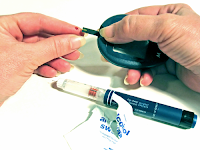 The word vitamin speaks for itself.
The word vitamin speaks for itself.
In 1912 Cashmir Funk, a Polish scientist first named that special substance he found in food as 'vitamine' from the two words 'vita' meaning life and 'amine' from thiamine, a compound isolated from rice husks. Today, we all know that vitamins are important for our health. They are needed for normal growth and body function.
Vitamins are a group organic substances occurring naturally in small amounts in every organism. They may be water or fat soluble. Vitamin A, D, E, and K are fat soluble, while B and C are water soluble.
Vitamin A
Also known as retinol, vitamin A is important for your eyesight, skin and mucous membranes, bone and teeth, and immune defense system. Avoid taking high dosage of vitamin A when you're pregnant. It's found in diary products, eggs, liver, orange-colored fruits and vegetables like carrots and apricots.Vitamin B
There are many types of vitamin B, namely thiamine (B1), riboflavin (B2), niacin (B3), pyridoxine (B6), cobalamine (B12). Even pantothenic acid and biotin are actually vitamin B. Generally they're important for energy metabolism, nerve function, and red blood cell formation. They're found in a variety of foods, mainly cereal and diary products, leafy vegetables, poultry, beef, fish. Except vitamin B12 that are not found in plants. That's why vegetarians are prone to B12 deficiency.Vitamin C
Also known as ascorbic acid, is a major antioxidant in our body important for immune system, tissue repair, skin health, and cartilage formation. It is found only in fruits and vegetable especially citrus fruits.Vitamin D
Vitamin D is needed for absorption of Calcium and bone health. It's found in liver, eggs yolk, milk, and fatty fish. The skin can make vitamin D when exposed to enough sunlight.Vitamin E
It is an antioxidant and protect the cell wall from damage. It is also important for reproductive function. Vitamin E is found in wheat germ and vegetable oil, cereal, liver, eggs yolk, green plants, and milk.Vitamin K
Vitamin K is needed for blood clotting. It is found in leafy green vegetables, butter, cheese, and egg yolk. The bacteria in our digestive tract also produces vitamin K and prolonged antibiotic therapy can cause deficiency.The most important source of vitamins is our diet- not from supplement pills or injections. You can not hope to replace a healthy and balanced diet with a bunch of high dosed supplements.
As stated before, vitamins are required only in a small amount. Taking high dosage of vitamins surpassing the Recommended Daily Allowance (RDA) will not not make your body function better. In fact, it can lead to over-dosage, especially for vitamins that are fat soluble because they are accumulated in our body, mainly in the liver.












